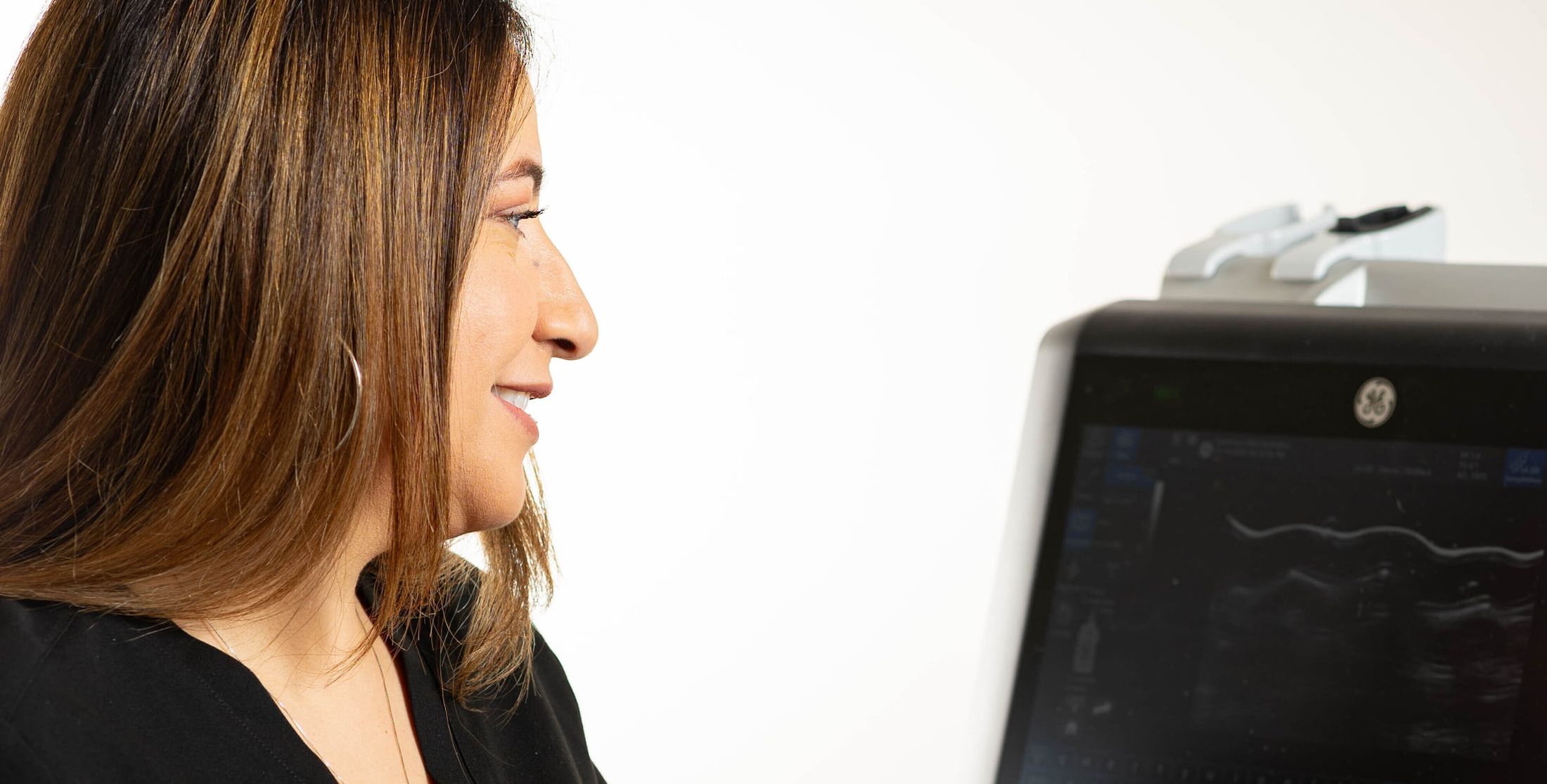



As a board-certified radiologist, Dr. Shaden at Luminous Medical Aesthetics in Woodland Hills incorporates ultrasound guided technology into the world of injectables to eliminate the guesswork- increasing precision and desired outcomes by knowing exactly where your filler is for targeted dissolve. Dr. Shaden is highly skilled in ultrasound-guided techniques for the reversal of migrated, unwanted, or problematic dermal fillers. The use of ultrasound in aesthetics is cutting-edge and paramount in identifying vasculature, minimizing adverse events, and the targeted dissolve of undesirable dermal fillers. Our treatments include Ultrasound-guided dermal filler dissolve with hyaluronidase, vascular mapping, and nodule evaluation.
Ultrasound is becoming the standard of care in the aesthetic realm for patient safety. Injectable treatments, such as dermal filler, have become a mainstay in the aesthetic space, allowing patients a minimally invasive option to enhance their appearance. However, like any medical procedure, there are risks associated with injectable treatments. If dermal filler is injected into a blood vessel, it can have serious consequences including skin necrosis and blindness. Dermal fillers may also be inadvertently injected into the wrong depth, causing issues such as a nodule, migration or an aesthetically displeasing result. Ultrasound guidance is critical for a targeted dissolve of problematic or unwanted HLA-based dermal filler.
At Luminous Medical Aesthetics in Woodland Hills Dr. Shaden uses ultrasound to identify dermal filler and uses ultrasound to guide the needle in real time to safely inject hyaluronidase while avoiding blood vessels to provide safe and effective results.
Ultrasound guidance for the reversal of migrated, unwanted, or problematic dermal fillers is crucial for effective results and safety. Ultrasound allows Dr. Shaden to locate the small aliquots of dermal filler in the face, and more importantly, will enable her to guide the needle into the specific sites requiring dissolve. Using ultrasound removes the guesswork of filler dissolve, which otherwise relies on flooding the area with the dissolving enzyme. Ultrasound guidance allows real-time identification of filler pockets and blood vessels to determine the safest needle entry points and depth to inject the hyaluronidase/dissolving enzyme precisely.
Some patients report an immediate relief of pressure, decreased swelling, improved breathing, resolution or improvement of a nodule, shadow, subtle asymmetry. Results often continue to improve over the next 48 hours to 1 week as your body continues to break down the filler and the post-procedure swelling improves.
Hyaluronidase is an enzyme used off-label to dissolve hyaluronic acid-based dermal filler. Hyaluronidase breaks down hyaluronic acid into sugars that can then be excreted by your body. Your native/natural hyaluronic acid and previous treatments you wish to preserve could also be dissolved. You could notice reduced skin elasticity and volume if some of your natural hyaluronic acid is degraded. However, native hyaluronic acid typically regenerates within a few days. It is common to have minor bleeding, bruising, some swelling or edema, and redness near the injection site(s). Some may have an allergic reaction to hyaluronidase; a skin test done before dissolving can often determine if there is an allergy.
The amount of dissolving enzyme needed varies from person to person. Factors that impact the amount of dissolving enzyme needed include the amount of dermal filler to dissolve, the type of dermal filler used, and the end goal of the patient.
Price varies case by case. At Luminous Medical Aesthetics we charge a base fee for the ultrasound guidance for the dissolve and per vial of dissolving enzyme used in the session. More than one session may be needed. Dermal filler placement can be a one and done appointment, however, dermal filler dissolve can be a journey depending on the type and amount of dermal filler that needs to be dissolved.

During your dermal filler dissolve appointment, Dr. Shaden performs a targeted ultrasound to evaluate the area of concern (nodule, lump, area of puffiness, etc.) to identify sites of dermal filler and assess the vessels. Ultrasound guidance is used to visualize the vessels and determine the safest needle entry point to inject the dissolving enzyme. Ultrasound is used throughout the dissolve appointment to guide the needle in real time into the dermal filler target. Ultrasound is also used at follow-up appointments to evaluate the interval improvement and assess for any residual filler.
Ultrasound is a safe, painless, and no radiation imaging modality used in Radiology. A thin layer of clear ultrasound gel is applied to the handheld ultrasound transducer. The ultrasound transducer is placed on the area of concern and the images are evaluated for the vascular anatomy, presence, and location of dermal filler, or nodule evaluation. The gel is wiped clean. After cleansing the skin, using a sterile technique, ultrasound-guided technology is used to guide needle placement to the ideal location for targeted dermal filler dissolve.
Results can vary. Some patients report an immediate relief of pressure or decreased swelling. Results continue to improve over the next 48 hours to 1 week post dissolve as the body continues to break down the filler and the post-procedure swelling improves. Follow-up treatments may be needed.

Following the dermal filler dissolve with ultrasound-guided technology, patients may notice some mild swelling, redness, or bruising around injection sites. These minor side effects will typically resolve within a few hours to a few days after your treatment.
You should avoid strenuous exercise and extreme heat for 24 hours but will be able to return to your regular daily activities immediately after your appointment. It is important to keep injection sites clean while they heal.
Yes, absolutely. Ultrasound guidance allows for targeted injection of the dissolving enzyme rather than flooding the area with hyaluronidase. Blood vessels are identified and avoided using ultrasound-guidance with safe needle entry points.
Your ultrasound-guided dermal filler dissolve treatment takes approximately two hours.
If a follow up dissolve is needed, it can be done as early as 3 days later.
Yes, if desired. Dr. Shaden suggests waiting approximately 2 weeks after dissolve.
While it is generally considered safe to fly after a filler dissolve treatment, the change in cabin pressure during a flight may exacerbate swelling and bruising. It may be beneficial to wait a few days before flying, if possible, to allow any initial swelling or bruising to subside.
To minimize bruising, avoid blood-thinning medications like aspirin or ibuprofen, fish oil or vitamin E for at least a week prior, stay hydrated, avoid alcohol for 24 hours before and after your appointment. If you are taking any prescription blood thinners, consult your primary care physician prior to discontinuing any medication. You may consider taking Arnica supplements to potentially reduce bruising.
Yes, as long as the dermal filler is a hyaluronic acid-based filler and can be identified, it can be dissolved.
Some people may be unhappy with their dermal fillers due to visible lumps, shadows, or swelling. In rare cases, the immune system may react to the filler months or years later, causing redness, swelling, or soreness. While antibiotics or steroids can help, dissolving the filler is typically necessary. Some may choose to dissolve filler before surgery. If there is worsening pain or skin color changes after filler placement, immediate dissolution may be needed as this could indicate a vascular blockage. Always contact your injector if you suspect a problem.